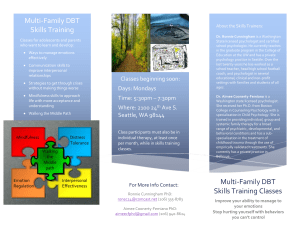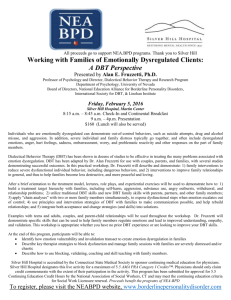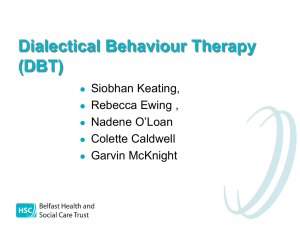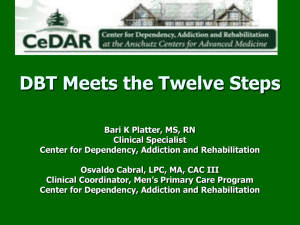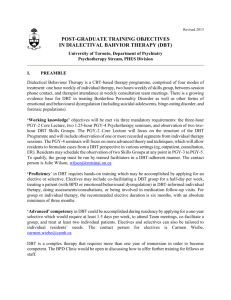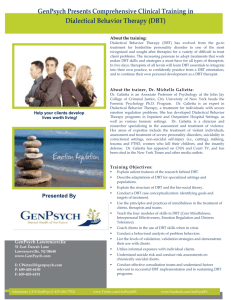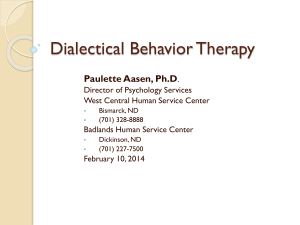Dialectical Behavioral Therapy in the Public Schools
advertisement
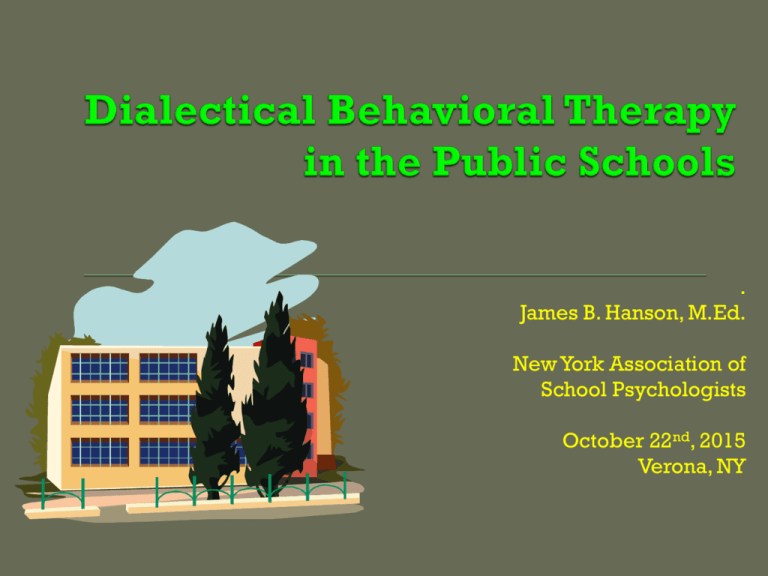
. James B. Hanson, M.Ed. New York Association of School Psychologists October 22nd, 2015 Verona, NY Dialectical Behavior Therapy in Public Schools What is DBT? Comprehensive cognitive –behavioral treatment developed to treat problems caused by pervasive emotion dysregulation: a) Chronic suicidal behaviors b) Non-suicidal self-injury Balances teaching acceptance-based and changebased skills Dialectical Behavior Therapy in Public Schools Emotional Regulation (labile, anger) Interpersonal Regulation (chaotic, abandoned) Self Regulation (identity, emptiness) Behavioral Regulation (suicide, cutting, impulsive) Cognitive Regulation (black and white thinking) Dialectical Behavior Therapy in Public Schools Why apply DBT skills to schools DBT skills focus on coping strategies and decision-making abilities (esp. emotionally difficult situations) Where could adolescents use these skills? 1. 2. 3. 4. 5. 6. 7. Alcohol and drug use Relationships with peer, family, and romantic Self-harming behavior Suicidal behavior Bullying victimization and perpetration Antisocial behavior Academic pressures Dialectical Behavior Therapy in Public Schools Outcomes for DBT For Adults reduction in suicidal behavior, self harming behavior, PTSD, depression, substance dependence, impulsivity, & BPD For adolescents Reduction in suicidal thoughts and attempts, self-harming behavior & depression (Miller et al., 2010; Neacsiu et al., 2010) Dialectical Behavior Therapy in Public Schools What is a Dialectic? Balance of polar opposites 1. Thesis, Antithesis, Synthesis 2. Actions, emotions, cognitions Acceptance & Change Dialectical Behavior Therapy in Public Schools Everyone has something to offer. I am doing the best I can and I can do better. I am tough and I am gentle. I may not have caused all of my problems, and I’m responsible for working on them. Dialectical Behavior Therapy in Public Schools Biological, Genes, Emotional Vulnerabilities Invalidating Environment (e.g., chronic stress, chaos, perfectionism, inconsistency) Can occur inside or outside the family setting Creating a Life Worth Living Adaptive Functioning DBT Treatment Hierarchy Increasing Behavioral Skills Decreasing Quality-of-Life Interfering Behavior Decreasing Therapy-Interfering Behavior Decreasing Life Threatening Behaviors Dialectical Behavior Therapy in Public Schools Potential Outcomes a) b) c) d) e) f) g) h) Less self-medicating Less use of alcohol and drugs Less risky sexual behavior and students feeling pressured to have sex Less self-harming behavior Less suicidal behavior Less bullying Less conduct problems and thus less suspensions and expulsions Less school dropout, better academic success measure through GPA, homework, etc. DBT Skills and Therapy Continuum of Services STEPS-A Curriculum DBT Therapy in Schools TIER I TIER II & III Health Teacher Trained Teacher School Psychologist School Psychologist School Counselor Social Worker Dialectical Behavior Therapy in Public Schools Components of STEPS-A = Skills Group/Large Class Components of SB-DBT = All Five Functions/Small Class “Phone Calls” DBT Individual Therapy Parent Group *Skills Group Consultation Team for Therapists Mindfulness Distress Tolerances Emotion Regulation Interpersonal Dialectical Behavior Therapy in Public Schools STEPS-A is a Universal program; selective if used with an at-risk population SB-DBT is an Indicated program; selective if used with students identified at risk and gauging RTI 5-10% 10-15% 80-85% Tier III Indicated Tier II Selected Population Tier I Universal Population Using MTSS model Emotional Problem Solving for Adolescents: Introduction to the STEPS-A Curriculum If DBT in Schools doesn’t work, then outpatient DBT for adolescents (Miller, Rathus, & Linehan, 2008) would be the next logical tier Hospitalization Tier VI SB-DBT Tier III Indicated Tier II Selected Population STEPS-A Tier I Universal Population Tier V Residential treatment Tier IV Outpatient DBT for Adolescents When In Wise Mind Behavioral Regulation Emotion Regulation Interpersonal Regulation Cognitive Regulation Self Regulation Dialectical Behavior Therapy in Public Schools Curriculum Structure– Recommended Sequence Mindfulness Interpersonal Effectiveness Distress Tolerance Mindfulness Mindfulness Emotion Regulation Dialectical Behavior Therapy in Public Schools Curriculum Structure STEPS-A and SB DBT CURRICULUM Mindfulness 1. 2. 3. 4. 5. 6. 7. Wise Mind Observe Describe Participate Non-judgmental One-mindfully Effectively Distress Tolerance 1. 2. 3. 4. 5. ACCEPTS Pros & Cons IMPROVE Radical Acceptance Turning the Mind Interpersonal Effectiveness Emotion Regulation 1. Observe/Identifying Emotions 2. Describing Emotions 3. Opposite Action 4. ABC 5. PLEASE 1. 2. 3. 4. 5. Ranking Priorities DEAR MAN GIVE FAST Evaluating Options Dialectical Behavior Therapy in Public Schools Core Mindfulness Mindfulness 1. 2. 3. 4. 5. Wise Mind Observe Describe Participate Nonjudgmental 6. One-mindfully 7. Effectively 1. 2. 3. 4. 5. Balance between emotion mind and reasonable mind Observe – just notice the experience (component of the How skills) Describe – put words on the experience (How skills) Participate – throw yourself completely into it (How skills) Non-judgmental – see but don’t evaluate, just the facts (What skills) 6. One-mindfully – be completely present (What skills) 7. Effectively – Focus on what works (What skills) Dialectical Behavior Therapy in Public Schools Distress Tolerance Distress Tolerance 1. 2. 3. 4. 5. 6. Pros & Cons ACCEPTS IMPROVE Self-Soothe TIP Radical Acceptance 7. Turning the Mind 8. Half Smile & Willing hands 9. Willingness 1. 2. 3. 4. 5. 6. 7. 8. 9. Evaluating strategy balancing pro’s/con’s of the decision & lack of the decision Distract with ACCEPTS -Activities, Contributing, Comparisons, Emotions, Pushing away, Thoughts, Sensations Imagery, Meaning, Prayer, Relaxation, One thing in the moment, Vacation, Encouragement Self-soothe through the 5 senses Changing body chemistry- Temperature, Intensive exercise, & Progressive muscle relax Freedom from suffering requires acceptance (acceptance ≠ approval) Turning the mind to the acceptance road Changing your emotions by changing your physical expressions Playing the cards that you were dealt and doing what works – opposite of willfulness Dialectical Behavior Therapy in Public Schools Emotion Regulation Emotion Regulation 1. Observe/Identifying Emotions 2. Describing Emotions 3. Opposite Action 4. Check the facts 5. ABC 6. PLEASE 1. Learning to recognize how emotions feel within your body 2. Learning the different words to describe emotions and what words to use when that emotion is elevated or low 3. Acting opposite to your current emotion action urge 4. Before making any decisions, checking the actual facts 5. Accumulate, Build mastery (do things you are good at) Cope ahead (rehearse a plan ahead of time 6. reduce PhysicaL Illness, balance Eating, Avoid drugs, balanced Sleep, Exercise daily Dialectical Behavior Therapy in Public Schools Interpersonal Effectiveness Interpersonal Effectiveness 1. Ranking Priorities 2. DEAR MAN 3. GIVE 4. FAST 5. Evaluating Options 1. Objectives, relationship, self-respect 2. Describe, Express, Assert, Reinforce – Mindful, Appear confident, Negotiate 3. Gentle, Interested, Validate, Easy manner 4. be Fair, no Apologies, Stick to your values, be Truthful 5. Low or high intensity for asking or saying No Dialectical Behavior Therapy in Public Schools Class structure Each class is structured similarly (80 minutes) a) b) c) d) Mindfulness (3-5 minutes) Homework Review (15-30 minutes) Teaching new lesson (30-45 minutes) Lesson summary and assignment of homework (5-7 minutes) Dialectical Behavior Therapy in Public Schools 20-30 minutes a week Diary card driven (Progress Monitoring) Share at deeper level FBA if emerging pattern of not doing homework, coming late, or other therapy-interfering behavior Dialectical Behavior Therapy in Public Schools Every student has the chance to receive immediate consultation during the week if trying to use skills and they aren’t working Accommodation in IEP or 504 to come to the counseling center to see their DBT coach Communicated to teachers if not on IEP/504 See the student before target behavior occurs Do not see the student for 24 or 48 hours after target behavior occurs Shaping appropriate help-seeking Dialectical Behavior Therapy in Public Schools Effectiveness research shows clearly that parent evenings are crucial Emphasis on validation, behaviorism, and communication Students whose parents come are the students who make the best gains Beyond the nuclear family Dialectical Behavior Therapy in Public Schools Purpose: “To allow therapists to discuss their difficulties providing treatment in a nonjudgmental and supportive environment that helps improve their motivation and capabilities” (Miller, et. al., 2007). “Group therapy for therapists” Integral part of DBT program Dialectical Behavior Therapy in Public Schools School Psychologist School Nurse School Social Work Intern School Psychology Practicum Student and School Psychology Intern School Counselor School Counseling Intern Dialectical Behavior Therapy in Public Schools Core Team Training: 6 Days, Portland DBT Readings: Miller (2007) Linehan (1993) Leader Training for School Psychologist: 6 Days, Portland DBT 6 Days per year, Behavioral Tech DBT in Action in the Schools Piloting School-Based DBT with Tier II & III students 1. Lincoln High School – Portland, Oregon 2. Battle Ground School District – Battle Ground, Washington 3. Mastery Charter Schools – Philadelphia, Pennsylvania 4. Oakland Unified School District – Oakland, California 5. Aloha High School – Beaverton, Oregon 5. BOCES Rockland County – New York 7. Pleasantville School District (MS & HS) – Pleasantville, New York 8. Ardsley School District (MS & HS) - Ardsley, New York Target population – same as research? Comprehensive DBT – all components? Setting – amenable finances, time, structure? Professional training – skill set, credentials? “Gold Standard” Five functions – skills, generalization, and environment of clients; capabilities and motivation of therapists Koerner, Dimeff, and Swenson DBT in Clinical Practice (2007) 1720 students Middle to high socio-economic status 100 Best High Schools in United States Suicide was leading cause of death until SB-DBT About 20 parent meetings/year for cutting, suicidal ideation or attempt (record year high was 45) High stress and anxiety (OHTS 2008: 13% of students considered suicide in last twelve months; 2012: 8.4%) Before DBT: one to two suicides per year, since DBT no suicides Before DBT: two placements into Portland Public School’s day treatment classroom per year, since DBT one placement in nine years “Advanced Health” on transcript; SB-DBT elective credit class Materials from Miller & Rathaus (reproducible) Monthly, not weekly parent training Lincoln Staff/Teacher Training (environmental contingencies) Consultation with community providers-not only MH service Weekly fidelity checks from Portland DBT Institute Program Memo of Understanding (2015) with Portland DBT Institute for individual therapist (they bill insurance); allows us to work with students that are more impacted by mental health issues STEPS-A in health classes (Tier One) and International Baccalaureate “Theory of Knowledge classes (Tier Two) + Lincoln High School 1600 SW Salmon St, Portland, OR 97205 RTI & PBIS Accountability Coordinated School Health Model PBIS and SEL Based on Oregon State Health Standards School Improvement Plan 40 MTSS 42 Self-referral from one-day preview of DBT skills in general education health classes MTSS/RTI: Students who did not do well enough in Reconnecting Youth or mentoring program IEP: Students identified with social/emotional needs Students in day treatment who have Collaborative Problem Solving Child Find meetings Tier classification depends on student If suicidal, not the only counseling service If suicidal ideation or eating disorder is serious, referral to Portland DBT Institute or other community-based therapy Step down or “graduates” from LHS SB-DBT, other programs, community DBT, and PPS day treatment as appropriate No requirement to quit other therapy: consultation with community provider Identifiable “target behavior” Parent involvement Orientation Checklist Adversity, health issues, personal problems and stress can challenge all of us. Are there issues that you are dealing with which might impact your academic success? Would it be helpful to talk with your school counselor about any of the issues you mentioned in the previous question? Suicide Attempts, Hospitalization, Serious Ideation (plan), pattern of self-injury Immediate Special Education Evaluation Team Meeting (Parents, Student, School Counselor & Psychologist) Suicide screening form completed Examine community-based resources Examine school-based resources • MTSS • Safety plan • Mental health referrals • Special education assessment • • • • • • • • • Explain how to build and maintain healthy relationships Classify personal stressors at home, in school, peers Describe how social environments affect well-being Identify resources at home, school, and in the community for managing family and relationship problems Practice strategies for managing and reducing stress, anger and conflict Demonstrate the ability to take the perspective of others in a conflict situation Identify influences that contribute to positive and negative selfimage Demonstrate pro-social communication skills Demonstrate the steps in problem solving, anger management and impulse control Oregon State Standard: Demonstrate the ability to take the perspective of others in a conflict situation DBT Skill: In classroom settings, Mary will use “validation” skills to repeat or reframe what a peer has said before she uses assertion and negotiation skills. This skillful behavior will occur 3/5 days as measured by her diary card (self-report) and 2 or fewer school discipline referrals per month. Mary’s use of validation skills will result in a DBT post-test score decrease (to 59 or lower) on teacher BASC-2 Aggression scale and an increase (to 41 or higher) on self-report BASC -2 Interpersonal Relations scale. 2009 2010 2010 2011 2012 2013 2014 2015 2016 Girl’s Group, Closed, Semester Mixed Group, Closed, Semester Mixed Group, Open, Year-Long Mixed Group, Closed, Year-Long Mixed Group, Closed, Semester Two Mixed Groups, Closed, Semester Three Mixed Groups, Closed, Semester Three Mixed Groups, Closed, Semester Two Mixed Groups, Open, Year-Long BASC-2 Pre and Post (Student, Parent, Teacher Versions) Attendance Grade Point Average Written Reflection Progress Monitoring: Daily Diary Cards • School Records • Formative and Summative Assessment • Pre- and Post-Testing Standardized Checklists Data from Attendance Credit Earned G.P.A. Measuring Attitudes, Beliefs, Behaviors Performance of Oregon State Health Standards Skills Written Reflections and Portfolio Work Samples • Student Work and Progress Monitoring BASC-2 Scores – Decreases in Anxiety (n=8), Depression (n=12) and Social Stress (n=7) Attendance - Increases up to 30% Grade Point Average – from no increase to 1.43, Average .80 “This group rocked. I learned a lot and you were pretty tough on me. You know that, right?” “All those chain analyses. They laid it all right out, like, ‘Girl, this is your life.’ It helped me quit smoking and I’m not cutting on myself anymore.” “Now I like myself. After group ended, a relationship failed. I did ‘accepting myself rehab’ and it worked.” “The Mindfulness skill allowed me to heighten my awareness of my limits. I’m more aware of when I’m overworked, or over emotional and I know what triggers the overload.” “My experience here with DBT has been truly life changing. I’ve developed skills that will help me the rest of my life.” Average increase in GPA = + .76 11 of 12 students increased GPA Average increase in attendance = + 4% Attendance not interpretable, 5/12 students decreased attendance slightly, 1 student significantly increased BASC-2 Self Report t-scores Anxiety: average decrease 13.9 (-35 to +6) Depression: average decrease 18.7 (-40 to 4) Internalizing: average decrease 15.2 (-37 to +4) ESI: average decrease 16.0 (-33 [2] to +2) ADHD not medicated Depersonalization Disorder Students with parent who did not attend parent classes Narcissistic traits: difficulty with group format Syllabus Administrative and parent buy-in School Improvement Plan Health Action Network Funds District support Scheduling class Scheduling individual appointments for students not in SPED Time intensity for program Training new staff every year Parent group Changing special education administration Perception of “therapy” versus “counseling” Research And It Ain’t Bad SB-DBT JIM HANSON, M.ED. STEPS-A JAMES MAZZA, PH.D. JABRHANSON@YAHOO.COM MAZZA@UW.EDU (503) 916-6087 (206) 616.6373
